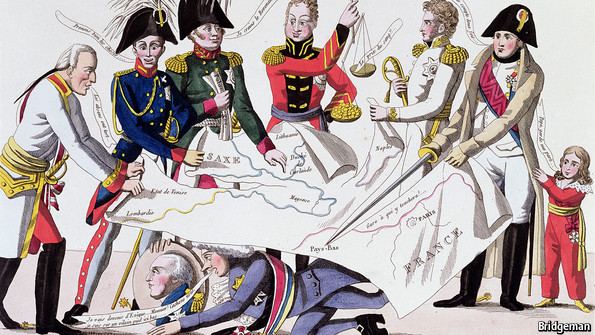European history
Reactionary days
How Europe invented the modern repressive state

Phantom Terror: The Threat of Revolution and the Repression of Liberty 1789-1848. By Adam Zamoyski. William Collins; 569 pages; £30. To be published in America by Basic Books in February 2015; $35. Buy from Amazon.co.uk
AFTER the revolution comes always the reaction. That is the central message of Adam Zamoyski’s scintillating and original book about Europe in the early 19th century. Many of those who had been steeped in the European Enlightenment welcomed the French revolution in 1789, and quite a few later came to admire Napoleon. Their common hope was that sweeping away the fusty old order in Europe would pave the way for modernisation, liberty and democracy.
Advertisement
Many of Europe’s political leaders played a part in this, including Talleyrand in France and Castlereagh in Britain. But the man whose policies came to dominate Europe for 33 years after the Congress of Vienna was a minor aristocrat from the Rhineland called Klemens von Metternich. He steered Austrian policy even before becoming chancellor in 1821.Yet the men who freed Europe from Napoleon’s rule—Russia’s Alexander I and Britain’s Duke of Wellington—were no liberals. Rather, they subscribed to the later dictum of Alexis de Tocqueville: that the most dangerous moment for a bad government is when it begins to reform. The policy of Europe’s governments both at and after the Congress of Vienna of 1814-15 (pictured) was largely reactionary, starting with a pigheaded insistence on restoring the Bourbons to the French throne.
With France still troubled, Prussia relatively weak, Russia mostly quiescent and Britain anxious to avoid more continental entanglement, it fell to Metternich to guard European autocracy against change and insurrection. Above all, the chancellor, who claimed that all Europe’s problems could be traced back to the evils of the French revolution, fought to preserve the ramshackle, backward and illiberal Austrian empire, which stretched from northern Italy to the borders of Russia.
Mr Zamoyski is a Polish aristocrat who has written extensively on the history of both his native country and Russia. In this book, his main focus is on how European governments came to develop the tools and methods of repression. As he says, today’s security services, anti-terrorism measures, spy networks and systems of policing all have their roots in Europe during the first half of the 19th century.
Thus Joseph Fouché pioneered the secret police in Napoleonic France; Britain’s Bobbies, named after Robert Peel, came into being in 1829; and Austria, Prussia and Russia all developed their own security services. This period saw the spread of censorship and the monitoring and interception of postal and other communications. As Mr Zamoyski suggests, it is not too fanciful to detect in Metternich’s Europe the birth of the modern police state.
It was also surely inevitable that, just as revolution had produced reaction, so the process would later be reversed. Tsarist Russia and Habsburg Austria were able to stay preserved in aspic for several decades. But France and Britain too were modernising and, in fits and starts, liberalising.
The Bourbons were overthrown in 1830, the same year that Belgium broke free from the Netherlands. The British government passed its Great Reform Act in 1832. By the 1840s Paris was once again the political capital of Europe, much to Metternich’s dismay. The concept of liberal democracy was spreading, with some inspiration being drawn from the success over the water of a young United States.
The end, when it eventually came in 1848, took the form of a series of convulsive explosions right across Europe. From Berlin to Vienna, and from Paris to Palermo, crowds of protesters and rioters came out, bent on overthrowing the old regimes. Paradoxically, Metternich had to flee to London, as did France’s King Louis-Philippe (the young Napoleon III had also sought refuge in England). Although not much else appeared to change after the 1848 revolutions, the stirrings of that year foreshadowed later movements towards Italian and German unification.
Oddly enough, 1848 is the weakest part of Mr Zamoyski’s book. He deals with the events of the year in around 20 pages and is a shade dismissive of its consequences. Yet the ultimate disintegration of Metternich’s beloved Austrian empire could be dated to that fateful year. And it was also in December 1848 that Franz-Joseph I, whose reign lasted right up to 1916, became emperor. Perhaps Mr Zamoyski will produce another volume on the later story.
沒有留言:
張貼留言